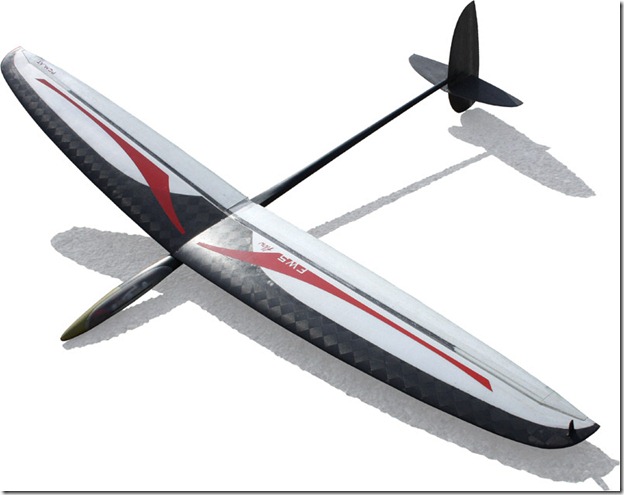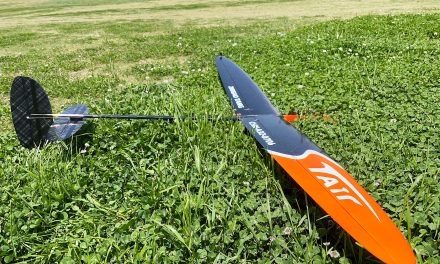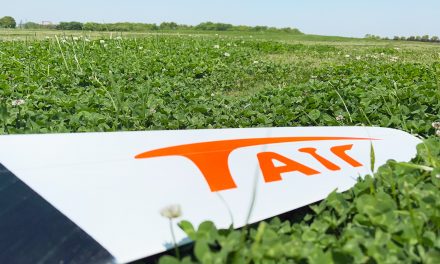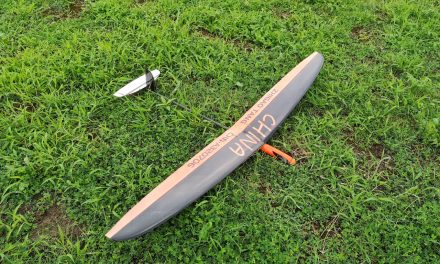Honestly, we can’t say it any better than PCM already has, so here it is, straight from the source :
After an intensive period of development, we present the successor model of our tried and tested series of Fireworks:
FLOW 5 is largely new construction. Not only the long version of the name was changed, we also have integrated several novelties concerning materials, method of construction and aerodynamic design. Numerous prototypes, more than 1000 test launches, and many tireless helpers (special thanks to Robert Mayer) were necessary, before we were satisfied with the overall concept.
Evolution
The new FW5 “FloW”: When we started developing a new F3K-model, a lot of people told us about their experiences and successful improvements. Our problem was, that we could not get any evidence that these changes really brought a progress. So we tried to prove all of this with test flights. First of all we had to find a good testing method to get serious data. After several trials we chose a comparing method with a DLG that is started at the same time from a rubber. So we had starts with constant energy, which made it possible to judge the atmospheric disturbances as wind and thermals.
The factors for a high start which we proved were (Performance such as L/D and minimum sink rate were calculated.):
- Centered masses
- Little masses
- Little/high dihedral
- Narrow wing tips
- Little/high sweep back
- Different aspect ratios
- Different airfoils: HM51, AG foils, Zone foils, and mixes and strakes of these
- Asymmetrical stabs
- Stabs with higher aspect ratio
- Different starting methods: steep or flat
- Shorter boom
After about 1000 test starts we realized the most important points to start high:
- Centering masses to keep the radius of gyration low
- Little flying masses
- The priority of these two points: centered masses are more effective than little masses.
- The pilot has to start in different ways when the wind varies. This makes a big difference!
Fuselage
The construction of the fuselage is a special novelty. It is produced as sandwich construction over the whole fuselage with airex and balsa as supporting material. This high effort in development and production is rewarded with fantastic weights of nearly 30g and simultaneously high stiffness.
The materials we used are:
- Kevlar in the front for 2.4ghz receivers
- IM spread tow in the back for good stiffness
- Airex sandwich in the front and balsa sandwich in the back for good strength
The fuselage is shorter in the back and the front to center the masses. Thermalling characteristics, especially agility and sensitivity for thermals have clearly been improved by this. You can easily stay in the thermal by making small steering movements or change the turning direction with nearly no loss of height.
Wing
Airfoil: Zone airfoils from 52-21. These airfoils are very suitable for high start and far distance flights. We chose again a wider wing tip like the FW4 has. We made tests with narrow wing tips to reduce mass at the tip. The result was bad during flight and also the strength of the tip decreased extremely. So we had to add more material to reach enough strength. That means in the end we had more weight and worse flying performance. So we chose again the wide tip that circles great and forgives mistakes. Now you can dare to thermal very low and near to obstacles. This sensitive feeling for thermals is also supported by centering masses.
Wing materials:
The D-Box is made of IM spread tow. We used more material in the middle of the wing to withstand the higher torsion forces and to center the masses. As the flying weight was near 250g, we could afford to integrate additional material. Further reduction of weight is not sensible, as the ideal conditions for a model like this (no wind, soft thermals) are very rare.
We used rohacell as supporting material to provide a smoother surface.
When searching the ideal place for the servos we first tried wing servos. As we needed some lead in the nose of the fuselage with this arrangement, the flying weight was 13g higher and also the distribution of the masses was worse. For this reason we came back to situating all servos inside the fuselage.
For joining of the ailerons there are levers to be hooked in on the downside of the fuselage. The servos are located in the fuselage.
Optimized distribution of the masses in the construction: More carbon spread-tow in the middle of the wing, the tubes in the ailerons are carbon at the inner side and glass on the outside of the wing.
After all tests we finally returned back to our well-established FW4.2 stabs, as we had the best results with these tails. In addition, these stabs are very popular amongst our customers in the meantime. The reasons for this are probably the good functionality, low weight from about 13,5g and the easy way of installing it.
Construction
Fuselage:
- Shell construction, with airex and balsa as supporting material and carbon as outer skin. We used among other things IM-carbon (for stiffness in the boom) and kevlar (for installation of 2,4GHz).
Wing:
- Shell> made of rohacell as supporting material and glass fabric or IM-carbon fabric (D-Box) as outer skin
- Spar booms made of carbon/shear web made of balsa planked with glass
Stabilizer:
- Shell made of balsa-sandwich with carbon fleece
Pre-fabrication:
- Ailerons are cut and mounted with elastic flaps
- Gap sealing of ailerons with adhesive
- Screw mounting for wing is pre-fabricated
- Openings in fuselage are cut, fitting of rudder is pre-fabricated
- Kitparts (radio board, pushrods, levers, ballast etc.) are included in kit
- GFR-stabs completely prefabricated apart from mounting the lever for rudder




















